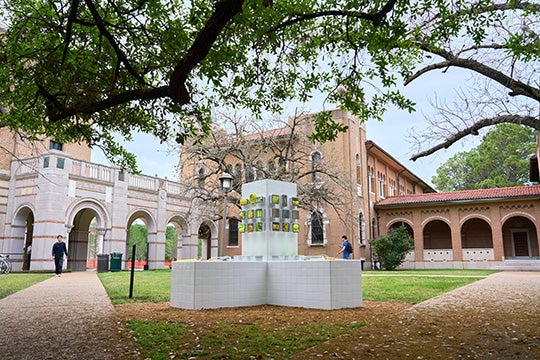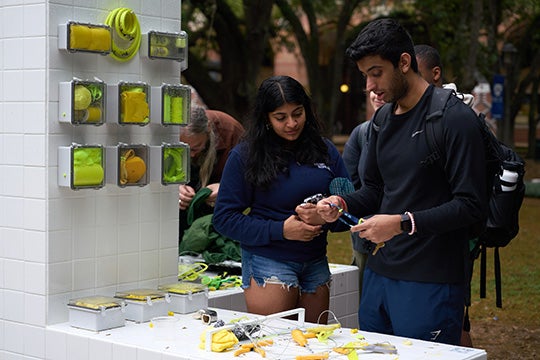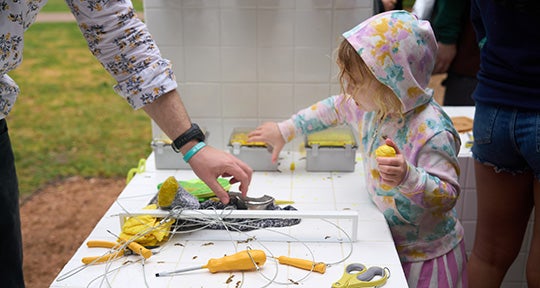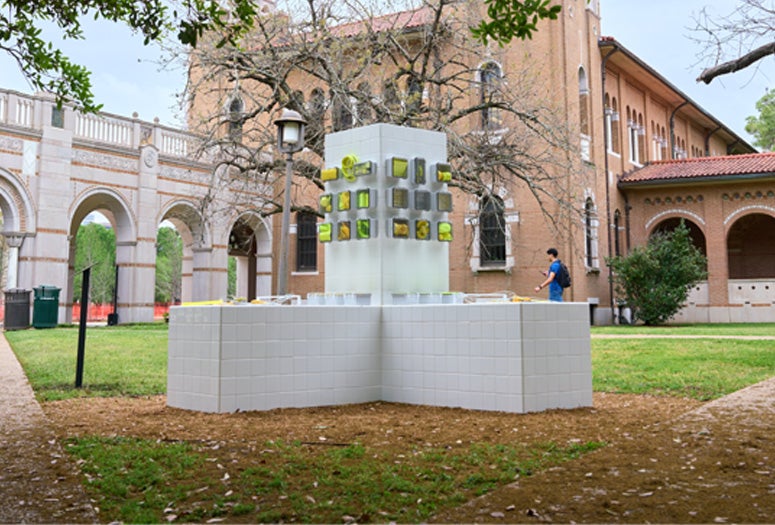At the busy intersection of academic life and everyday student traffic, a striking white and yellow structure has appeared on Rice University’s campus. Bright white, tiled and stocked with an assortment of yellow tools and materials, “Repair Station” invites passersby not just to look but to mend.
The interactive sculpture created by North Carolina-based artist Julia Gartrell is the latest commission in the Moody Center for the Arts’ Platform series. Focused on temporary, site-specific works, the series challenges artists to respond to architecture, exhibitions and research at Rice. For “Repair Station,” that prompt came from an ongoing theme at the university’s Humanities Research Center (HRC): repair. Set just outside Lovett Hall, home of the HRC, the installation resembles a utilitarian kiosk — an approachable, functional place to stop and fix what’s broken.

“We really wanted to have something that got students specifically thinking about repair in a physical way,” Gartrell said.
Gartrell, who works with found and repurposed materials, has long explored themes of mending and restoration, especially through the lens of Southern and Appalachian craft. In 2020, she launched the Radical Repair Workshop, a mobile initiative that engages communities through making and mending. Her work merges oral history, sculpture and traditions of artisanal practices.
“My own work is based in a lot of Southern craft traditions and looking at why we use materials in certain ways,” she said. “That pushed me to think about repair as a sculptural space.”
On view until May 10, “Repair Station” is stocked with scissors, thread, buttons and more — supplies that can be used to fix a torn backpack or broken keychain. Instructional videos accessed via QR codes offer how-to guides featuring craftspeople Gartrell interviewed who share insights into the evolving culture of repair.

“They’re reflecting on the changes in material culture,” Gartrell said. “They’re reflecting on the future of repair — if there is a future of repair in their particular genre.”
Curator Frauke V. Josenhans, who organized the project in collaboration with the HRC, said she was drawn to Gartrell’s approach to art as both a resource and an open invitation.
“Repair is an act of care that transcends the object itself,” Josenhans said. “In ‘Repair Station,’ Julia explores repair as something communal, empowering and even joyful. With her public artwork she offers a space where material transformation becomes a metaphor for personal and social revival and the beginning of a new conversation.”
Though the sculpture may resemble a public utility, it’s also a provocation. Gartrell wants people to imagine a world where fixing things, such as tying a loose shoelace or reattaching a button, is not just possible but becomes a common practice.
“What happens if repair was a cultural norm like it used to be,” Gartrell said. “We’re in a time period where things aren’t really made to be repaired.”

Students, staff and visitors are encouraged to approach, explore and use the “Repair Station” materials freely. Early in the spring semester, the installation was activated with two workshops that taught specific repair techniques.
“My dream is that the yellow repairs will start to filter out on campus,” Gartrell said.
That sense of play and experimentation is central to the Platform series, said Alison Weaver, the Suzanne Deal Booth Executive Director of the Moody.
“‘Repair Station’ exemplifies the kind of thought-provoking, community-engaged work we strive to bring to campus through Platform,” Weaver said. “Julia’s project challenges our assumptions about art, labor and public space while offering something deeply practical and accessible.”
“People should feel really comfortable going up to it, playing and using the materials,” Gartrell said. “You don’t have to know what you’re doing.”
And maybe that’s the point: Repair isn’t just about fixing what’s broken. It’s about believing you can.

